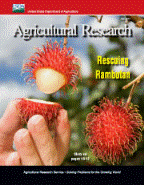United States Department of Agriculture: Agricultural Research Service, Lincoln, Nebraska

Agricultural Research Magazine
Date of this Version
7-2013
Document Type
Article
Citation
Agricultural Research July 2013
Abstract
A recently discovered wild strawberry species provides new genetic material for plant research and, in the future, might also provide a new class of commercial strawberries.
Agricultural Research Service scientist Kim Hummer, with the USDA-ARS National Clonal Germplasm Repository at Corvallis, Oregon, found the new species during several plant collection expeditions in the high peaks of Oregon’s Cascade Mountains. She named it Fragaria cascadensis.
The find was reported in the Journal of the Botanical Research Institute of Texas.
The new strawberry is endemic to the Oregon Cascades, hence its specific name, F. cascadensis. It is perennial, with white flowers and green leaves, and it differs from other strawberry species of the region by having hairs on the upper side of its leaves; a different-shaped middle leaflet; comma-shaped, small brown fruits (called “achenes”) on the strawberry surface; and 10 sets of chromosomes, unlike the 8 sets of chromosomes of the commercial strawberry, according to Hummer.
“The new strawberry species begins growing after snowmelt in late May or early June and flowers in early July. Runner production begins after flowering, and fruit ripens during August for about 2 weeks,” says Hummer. “The fruits of plants at about 5,000 feet elevation ripen 1 to 2 weeks later than those at 3,280 feet.”
The strawberry’s distribution in the Oregon Cascades stretches from the Columbia River in the north to the vicinity of Crater Lake in the south, at elevations of about 3,000 feet up to tree line. It grows in sandy-clay loam soil of volcanic origin located in forest clearings and open alpine meadows. The northern distribution range of F. cascadensis has an average annual precipitation of 12-15 inches, but the southern range receives only about 6 inches of precipitation annually.
Included in
Agriculture Commons, Animal Sciences Commons, Food Science Commons, Plant Sciences Commons

